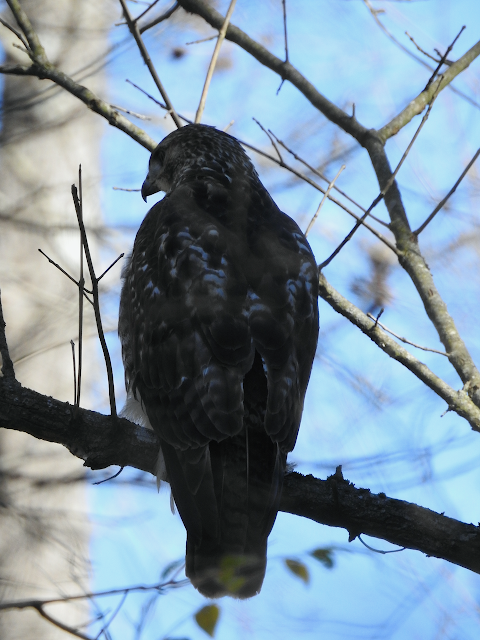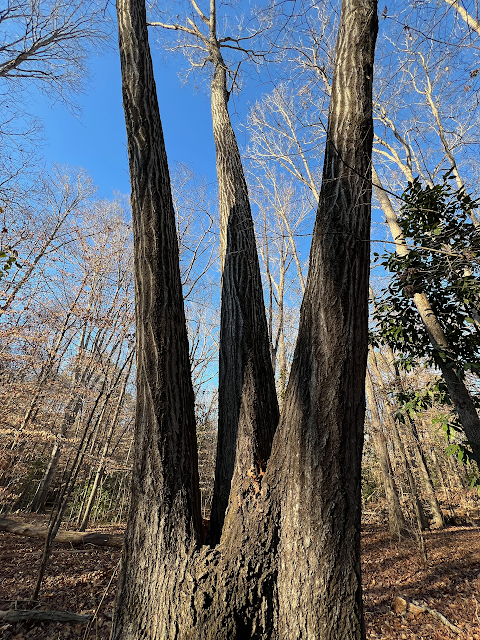 |
| Eclipse Art in the Park |
I have seen a few partial solar eclipses over the years. The first I recall was when I was in high school. I stood out on the front steps of the building with my classmates and we took turns looking through sheets exposed film, which in hindsight, wasn't so smart. In later years I showed my kids how to observe the sun safely on a piece of paper through pinhole cameras, and watching the myriad tiny eclipse images that shone through the leaves on the trees and onto the sidewalk. We got about 80% of the Annular Eclipse last fall and were able to watch it with our granddaughter. Eclipses are really special events.
 |
| Mini Eclipses through the leaves in 2017. We never saw these this time. |
In 2017, my husband and I had the exciting chance to see a total solar eclipse just about an hour's drive from our home here in Athens, GA. We weren't sure what to expect, but we had our safe eclipse viewing glasses this time (no exposed film), and I brought my camera to try to photograph the event. I did take photos once we were in total darkness, but I had not thought about needing a filter for the camera as the eclipse was progressing, so I did not get any images of the sun slowly disappearing. It was an amazing experience. Nothing really prepared us for the full deal. The difference between the filtered light of a partial eclipse and the total eclipse is hard to even express. I wrote about the 2017 eclipse in my blog here. At the end of the day we knew that if we had a chance to see another total eclipse we would jump on it. Immediately after the eclipse, the news reported on upcoming solar events and it turned out that the next one would be on April 8, 2024, and Little Rock, Arkansas, where our daughter lives, would be right in the zone of totality!
 |
| Gotta Be Safe! |
I'm happy to report that we made good on our promise and were able to take the trip to Little Rock for the total eclipse last week. We were nervous about the weather right up to the day before. Rain and clouds were on and off in the forecast for weeks. And the state of Arkansas warned about traffic problems with the huge crowds that were expected. The governor declared a state of emergency.
 |
| Party in a Box |
 |
| So Fun! |
 |
| Eclipse Ice Cream is the Best Kind! |
 |
| Arkansas Travelers Getting in on the Fun! |
We woke up Monday morning to a clear, nice day and set up our chairs and snacks and gear on the driveway in our daughter's front yard! It's so convenient to live in the path of an eclipse! The City of Little Rock gave away some cute Eclipse Watch Party boxes. They had fun themed items like Moon Pies, Capri Sun, Sun Chips, Sunflower Seeds and Orbit Gum. Pretty cute. The state transportation department had some amusing electronic signs on the highway. The whole town was getting into the spirit. A local creamery created special "Dark Side of the Moon" Ice Cream. The Arkansas Travelers baseball team wore jerseys with a total eclipse on the back and sold them after their weekend series as a fundraiser for the team. Downtown there was an Eclipse Fest with a Pink Floyd cover band. Free eclipse glasses all around!
 |
| Awkward and Wobbly Tripod |
 |
Heavy, but much better. Totality is only 3 minutes!
|
I was better prepared for photography this time. I bought a filter for my camera and got a lot of images of the partial sun. I practiced using the filter to take shots of the full sun before we left for our trip. I still wasn't quite prepared for the whole event, though. There are so few opportunities to photograph a total eclipse that I couldn't really practice in the dark, so each time was a learning experience. When the sun was suddenly covered by the moon, I forgot that I had to take the filter off to see anything and fumbled for a few seconds trying to find the eclipse in the viewer before pulling off the filter and snapping away. If I do this again I might bring a sturdier tripod. But I did ok holding the camera in my hands.
 |
| Eclipse Family! |
 |
Sun through the strainer
|
 |
| Eclipse Sparkles |
We were also prepared to entertain and protect a 4 year old. We helped her decorate a paper plate to hold her glasses against her face. This was an ingenious idea found online. We also brought out a colander to use as a pinhole viewer on the ground, and a sequined stuffed animal to shine little eclipses. The images through the colander proved pretty unsatisfying, and we also didn't see the changes in the light shining through the leaves of the trees on the ground. I don't know why. The sparkly sequins gave a fun effect. A few neighbors came out on their lawns to watch, and we could see people at nearby businesses outside, too. It was very merry.
 |
| Full Sun (taken in Athens as a test--sun spot is in different location in later photos) |
As the visible sun appeared smaller and smaller, the light changed and it started to feel like dusk at 1pm. Confused birds called. Sensors up and down the street turned porch lights on. The sky was darkening and the temperature dropped. Because we were in the city with traffic sounds, we didn't hear insects like crickets, but still everything seemed quieter. Just as it got totally dark a large flock of crows flew overhead, cawing loudly. Suddenly it was dark and we all tore off our glasses to look at the marvel of a completely blocked sun. We could see stars. The sun's corona glowed from behind the moon and we could see colored flashes that were solar prominences. The totality lasted almost 3 minutes, which was much longer than we had in 2017, at 1 minute, 20 seconds. It was one of the prettiest things I've ever seen. All of us just stood and marveled. Even the four year old.
 |
| Totality |
 |
| Corona and Prominences |
 |
| Corona and Prominences |
 |
| Baily's Beads--Light rays from the Sun streaming through the valleys along the Moon's horizon. |
 |
| "Diamond Ring" Effect |
And then the first flash of light, called the "diamond ring effect" and the totality was over. The sun is so incredibly bright that a tiny sliver of light from the edge lights the sky and burns the eyes. Glasses and filters back on, and we watched the cheshire cat smile of the sun growing from the bottom of the sun up as the moon continued in its path.
I'm not sure, but I think that after doing this two times, I may want to be an umbriphile, or person who chases eclipses. The next one will be visible from Iceland and Spain in 2026. Sounds pretty good! Or better yet, Australia has 4 coming up between 2028 and 2038! But this was the last viewable in the US until 2044, so I'm awfully glad we got to see this one! Shine on!

















































